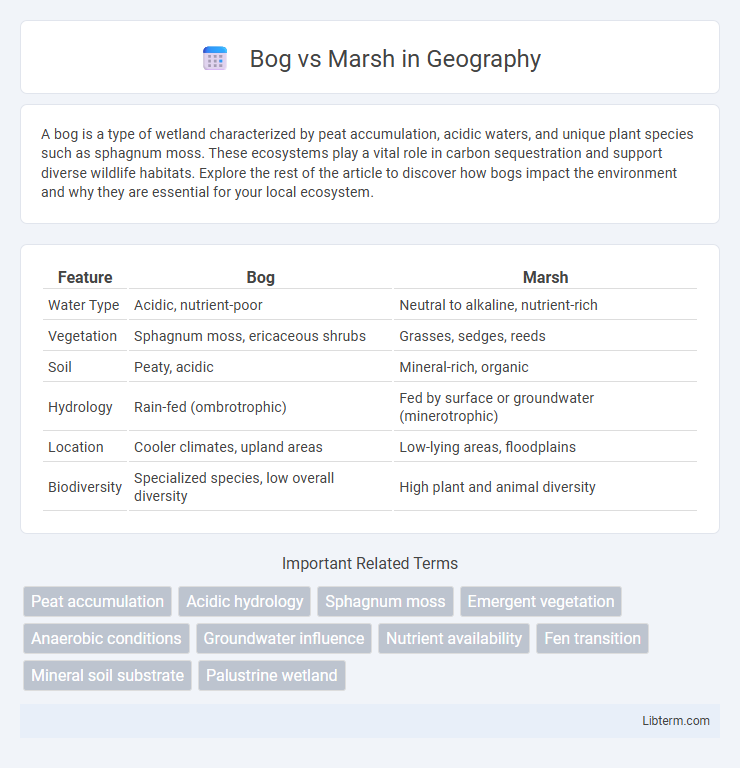A bog is a type of wetland characterized by peat accumulation, acidic waters, and unique plant species such as sphagnum moss. These ecosystems play a vital role in carbon sequestration and support diverse wildlife habitats. Explore the rest of the article to discover how bogs impact the environment and why they are essential for your local ecosystem.
Table of Comparison
| Feature | Bog | Marsh |
|---|---|---|
| Water Type | Acidic, nutrient-poor | Neutral to alkaline, nutrient-rich |
| Vegetation | Sphagnum moss, ericaceous shrubs | Grasses, sedges, reeds |
| Soil | Peaty, acidic | Mineral-rich, organic |
| Hydrology | Rain-fed (ombrotrophic) | Fed by surface or groundwater (minerotrophic) |
| Location | Cooler climates, upland areas | Low-lying areas, floodplains |
| Biodiversity | Specialized species, low overall diversity | High plant and animal diversity |
Understanding Wetlands: Bog vs Marsh
Bogs are acidic wetlands characterized by peat accumulation, nutrient-poor conditions, and dominance of sphagnum moss, whereas marshes are nutrient-rich wetlands with neutral to alkaline waters, primarily dominated by herbaceous plants like cattails and reeds. Bogs receive water mainly from precipitation, causing low nutrient input, while marshes are fed by surface or groundwater, enhancing nutrient availability that supports diverse plant and animal life. Understanding these differences is crucial for wetland conservation, as each ecosystem plays distinct ecological roles in water filtration, carbon storage, and habitat provision.
Definition and Key Characteristics
A bog is a type of wetland characterized by acidic, nutrient-poor water and peat accumulation primarily from sphagnum mosses, creating a spongy surface often found in cooler climates. Marshes are wetlands dominated by herbaceous plants such as grasses, sedges, and reeds and typically have nutrient-rich, neutral to alkaline water with standing or slow-moving water. Both serve as crucial ecosystems for water filtration and habitat but differ significantly in their vegetation, water chemistry, and peat formation.
Formation Processes
Bogs form in cool, wet climates through the accumulation of partially decomposed sphagnum moss, creating acidic, nutrient-poor conditions that limit microbial breakdown and promote peat buildup. Marshes develop in wetlands with consistent water flow, where sedges, grasses, and herbaceous plants thrive in nutrient-rich, neutral to alkaline soils, leading to organic matter accumulation from decaying vegetation. Both ecosystems rely on water saturation, but bog formation emphasizes sphagnum moss accumulation and peat development, while marsh formation hinges on mineral-rich sediment deposition and diverse plant decay.
Water Sources and Hydrology
Bogs primarily receive water from precipitation, leading to nutrient-poor, acidic conditions with limited mineral input, while marshes are influenced by groundwater or surface water, resulting in higher nutrient availability and less acidity. The hydrology of bogs is characterized by stagnant, poorly drained waterlogged soils that sustain sphagnum moss, whereas marshes feature more dynamic water flow, supporting emergent vegetation like cattails and reeds. These hydrological differences impact the biodiversity, carbon storage capacity, and ecosystem functions distinctive to each wetland type.
Soil Composition and Peat Accumulation
Bog soils are predominantly acidic and nutrient-poor, with a high concentration of sphagnum peat formed from partially decomposed organic material under waterlogged, anaerobic conditions. Marsh soils tend to be more mineral-rich and neutral to alkaline, containing silts and clays with less peat accumulation due to higher rates of organic matter decomposition. Peat accumulation in bogs is substantial and forms thick layers over centuries, while marshes accumulate thinner organic layers influenced by regular flooding and sediment deposition.
Plant Life: Unique Vegetation
Bogs feature specialized vegetation such as Sphagnum mosses, ericaceous shrubs, and carnivorous plants adapted to acidic, nutrient-poor conditions. Marshes support a diverse array of herbaceous plants like cattails, sedges, and grasses thriving in nutrient-rich, water-saturated soils. The unique plant life in bogs and marshes reflects their distinct hydrology and soil chemistry, influencing ecosystem biodiversity.
Wildlife and Biodiversity
Bogs support a unique array of wildlife including sphagnum moss, carnivorous plants like pitcher plants, and specialized insects adapted to acidic, nutrient-poor conditions. Marshes harbor greater biodiversity with abundant emergent vegetation, providing habitat for diverse bird species, amphibians, and fish. The contrasting water chemistry and vegetation structures in bogs and marshes create distinct ecosystems crucial for maintaining regional wildlife diversity.
Climate and Environmental Importance
Bogs store significant amounts of carbon, acting as vital carbon sinks that help mitigate climate change by reducing atmospheric CO2 levels. Marshes provide critical habitats for diverse wildlife and improve water quality through natural filtration processes. Both ecosystems regulate local climates by maintaining humidity and moderating temperature extremes, supporting biodiversity and environmental stability.
Human Impact and Conservation
Bog ecosystems, characterized by acidic, nutrient-poor conditions, often suffer from peat extraction and drainage, leading to habitat loss and carbon release. Marshes, typically nutrient-rich wetlands, face threats from urban development, pollution, and invasive species, disrupting native biodiversity and water purification functions. Conservation efforts prioritize restoring hydrology, protecting native vegetation, and implementing sustainable land-use practices to mitigate human impacts on both bogs and marshes.
Key Differences: Bog vs Marsh Comparison
Bogs are acidic, nutrient-poor wetlands dominated by sphagnum moss and slow-decaying organic matter, while marshes are nutrient-rich, frequently flooded wetlands characterized by herbaceous plants like grasses and reeds. Bogs accumulate peat due to waterlogged, anaerobic conditions, whereas marshes have mineral-rich soils influenced by surface water and periodic flooding. The water source for bogs is primarily precipitation, resulting in low nutrient input, contrasting with marshes that receive water from rivers or groundwater, supporting higher biodiversity and productivity.
Bog Infographic

 libterm.com
libterm.com